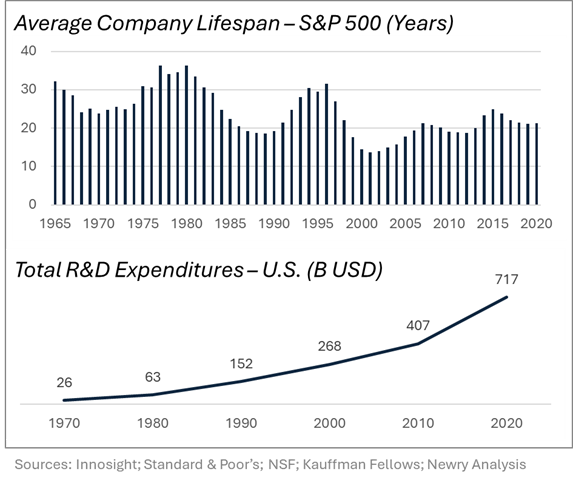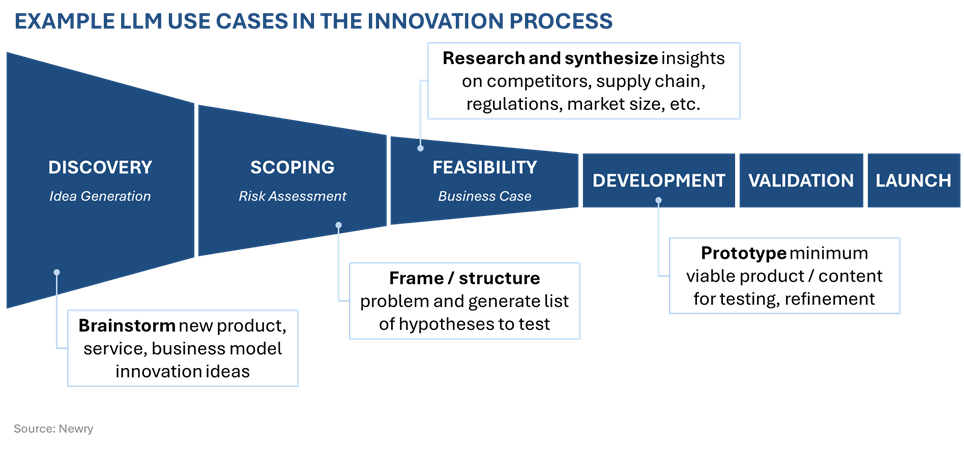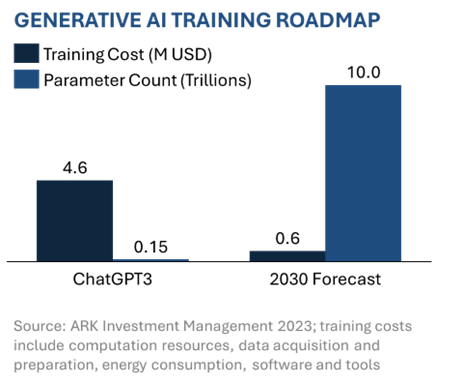The average company lifespan is declining. R&D expenditures are rising exponentially. Markets and technologies are constantly being disrupted. Your organization’s survival depends on its ability to innovate fast and to efficiently to deliver growth.

With a finite amount of investment dollars and growing pressure to maintain a competitive edge, companies must identify, vet, and scale new product, service, and business model opportunities rapidly. Any concepts with low growth potential need to be killed off early to “fail fast” so that resources can be reallocated to fast-track and scale winning projects.
And so, the ever-pressing question remains: How can we accelerate innovation to sustain long-term growth?
Large Language Models (LLMs) as an Enabling Tool
You’ve probably heard a lot about large language models (LLMs) already—ChatGPT, Perplexity, Gemini—they’re generative AI systems designed to understand prompts and create output as human-like text. They can answer complex questions, summarize vast amounts of information, provide insights, and support creative processes.
With continued investment in LLMs—which is growing at 74% CAGR according to McKinsey—the next few years will bring along unimaginable new and improved capabilities. But LLMs already have the potential to drive significant productivity gains across various workstreams, including B2B market research and innovation.
For example, LLMs can brainstorm new products, services, and business model innovation concepts that tie to an organization’s technical and commercial capabilities and target markets. This can be applied for multiple positions in the value chain, be it additive suppliers, equipment OEMs, or end-product adhesive and sealant manufacturers. In addition, they can structure problems and frame hypotheses around “what must be true” for a given innovation to succeed.
Their capabilities also extend to researching and synthesizing large data sets to develop insights around market attractiveness, growth, competitive dynamics, technological trends, disruptions, regulatory changes, and other factors. And when it comes to refining and testing new product and service concepts, they can draft and prototype content, including marketing and pitch materials.

LLMs in Action
“In our experience, LLMs have been extremely useful for helping with ideation,” says David Wylie, Vice President of Newry. “For more than a decade, we’ve leveraged automated techniques to surface unmet needs in big data sets that have allowed us to identify opportunities that drive growth in adjacent markets and applications. We’ve adapted our process to supercharge the way Fortune 500 and PE-backed portfolio companies within the B2B space, including adhesives and sealants players, approach growth strategy. Our tools have evolved over the years but with recent LLM advancements, we’ve found that the approach all starts with prompt engineering.”
Prompt engineering skills enable rapid ideation and allow users to gain a variety of concepts that overcome some of the pre-LLM innovation follies of relying solely on market pull or tech push. Strictly using “market pull” ideation often leads to focusing on meeting existing customer needs that result in incremental innovation, reacting to and overemphasizing current trends, and staying within familiar territories. While on the other hand, “tech push” ideation is often misaligned with market needs, comes at higher cost, and risks developing cutting-edge solutions that do not resonate with consumers.
LLMs can help you sidestep these pitfalls by considering multiple perspectives, bridging market needs with technology, processing technological trends and predicting market shifts, and serving as a cost-effective way to iterate and explore difference concepts to accelerate ideation. With appropriate prompt engineering techniques, organizations can mitigate the reactive nature of market pull, reduce the risk of tech push misalignment, and improve the overall innovation process with data-driven insights.
“There are several ways to get the appropriate coverage with prompt engineering, but the three techniques I use most often are market- / megatrend-led prompts, capability-led prompts, and persona-based prompts,” Wylie says.
Market- / megatrend-led prompts focus the tool on markets or megatrends of interest to ensure ideas are aligned with strategic growth areas. Capability-led prompts require inputting detailed capability statements describing technical product specifications for the tool to brainstorm adjacent uses. Finally, persona-based prompts assign the tool a persona to center its brainstorming around, which of course will yield different results and advantages depending on that role’s traits.
“For example, imagine a company with unique technologies that enhance and stabilize the dispersion of different additives used in CASE formulations. A megatrend-led approach may focus the tool on the growth of battery electric vehicles in the automotive space, whereas a capability-led approach might focus on an application with problems to solve—in this case, aqueous dispersions for flexible packaging with agglomeration issues.”
EXAMPLE PROMPTS AND OUTPUT FOR DISPERSION TECHNOLOGY
| Approach | Example Prompt | Example Output |
| Market- / Megatrend-led | Imagine you are looking for problems to solve as they relate to dispersions in the adhesive and sealants industry. A key trend you are interested in is the growth of battery electric vehicles. Brainstorm one application. | Thermal management adhesives for EV batteries
|
| Capability-led | Imagine you have a new dispersion tech that enables production of extremely stable aqueous dispersions – i.e., sub-micron particle sizes, high stability, and no agglomeration. Brainstorm one application in adhesives and sealants. | High-performance water-based adhesives for flexible packaging, including multi-layer films |
Source: Newry examples, generated by ChatGPT
Users can further tailor how LLMs approach ideation by assigning a specific persona. The tools will take on different perspectives to ideate from, and these different roles will offer unique traits and advantages that allow for a more diverse set of ideas to consider.
PERSONA EXAMPLES AND SAMPLE OUTPUT FOR DISPERSION TECHNOLOGY
| Persona | Traits | Example Output |
| Entrepreneur | Innovative, risk-taker, visionary, tendency for market disruption | Expansion joint sealants for bridges, roads, and large concrete structures |
| Technical Expert | Detail-oriented, conservative, focus on tech feasibility, practicality | High-performance pressure-sensitive adhesives (PSAs) used in medical, automotive, and electronics industries |
| Student | Curious, open-minded, creative but less practical | Curtain wall and glazing sealants for high-rise buildings |
| Customer Advocate | Empathetic, focused on user needs and experience | Water-based adhesives for subfloor installation |
Source: Newry examples, generated by ChatGPT
 “We’ve found using LLMs accelerated the market research for many relevant activities our clients needed to explore within numerous areas of interest, including market landscaping and sizing.” However, Wylie cautions that there are limitations to LLMs. “It’s not a silver-bullet solution. Users will still struggle with getting the tool to provide relevant ideas, and it still requires vetting concepts against criteria. There’s no way around it. Regardless, LLMs, if harnessed effectively, can accelerate innovation and serve as an amplifying tool.”
“We’ve found using LLMs accelerated the market research for many relevant activities our clients needed to explore within numerous areas of interest, including market landscaping and sizing.” However, Wylie cautions that there are limitations to LLMs. “It’s not a silver-bullet solution. Users will still struggle with getting the tool to provide relevant ideas, and it still requires vetting concepts against criteria. There’s no way around it. Regardless, LLMs, if harnessed effectively, can accelerate innovation and serve as an amplifying tool.”
LLMs are not a substitute for human expertise and judgment, but as they continue evolving at an impressive rate, our ability to unlock their potential is dependent upon continuously upskilling our teams and methodologies. “To accelerate how we innovate with LLMs to deliver growth, we must continue to be fast—experimenting, failing, learning, iterating, collaborating—to define best practices.”
Note: This article was co-written by Kasey Correnti and Adam Rounick and originally appeared in the Adhesives and Sealant Council’s October 2024 ASC Showcase publication. It was written to accompany a presentation at the 2024 ASC Executive Leadership Conference.
